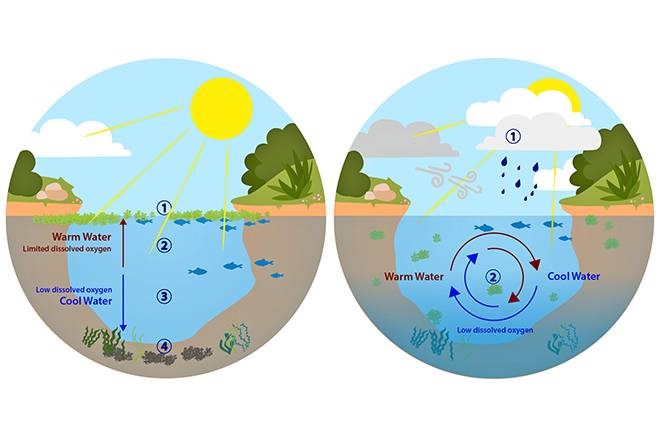Fish kills are defined as a sudden mass mortality of wild fish. Fish kills can occur at any time, though data indicates fish kills are more likely to occur in summer or following sudden changes in temperature.
Some of the key causes of fish kills are outlined in the information below.
Blackwater
Blackwater occurs naturally over time when leaf litter and woody debris build up on the floodplain and then get washed into the river system during a flood.
It’s an important part of the aquatic food web, as it provides food for insects, which feed fish, frogs and other aquatic wildlife.
When there is a prolonged dry period, the leaf litter and organic matter on the floodplain builds up until the next flood event.
This can result in a significant amount of organic matter returning to the river with any big flushes of water after prolonged drought, making blackwater events more likely.
Hypoxic blackwater
When there is a lot of organic material washed into the river, its rapid decay can consume dissolved oxygen from the water.
If dissolved oxygen drops to very low levels, this can cause ‘hypoxic’ water, which can be stressful for native fish and can lead to fish kills.
Bushfires
Bushfires can also influence water quality and cause conditions similar to blackwater events.
After a bushfire, rain can carry ash and burnt material into waterways.
The cover offered by plants and trees is lost, meaning the soil is more easily eroded and can be washed into rivers.
This can contribute to unpredictable changes to the water chemistry, including to blackwater events.
More information on blackwater can be found on the MDBA website, mdba.gov.au/climate-and-river-health/water-quality/blackwater, and in the ‘About blackwater’ factsheet from DPIE Environment, Energy and Science, environment.nsw.gov.au/-/media/OEH/Corporate-Site/Documents/Water/Water-for-the-environment/about-blackwater-fact-sheet-200209.pdf
To notify the department of potential blackwater events, email waterqualitydata@dpie.nsw.gov.au or to report a fish kill, contact the Fishers Watch Phoneline on 1800 043 536.

Stratification
Stratification is when the surface of the water heats up more than the deeper water.
That warmer layer tends to be warm and well-oxygenated compared to the deeper water that is colder and oxygen-depleted.
Thermal stratification
Blue green algal bloom
- Algal flourish in warm and still conditions, particularly in the absence of high flow.
Surface water layer
- Warm high nutrient load from run off
- Dissolved oxygen by day, depletion overnight
- Limited fish habitat.
Deep water layer
- Cooler low light penetration
- Low dissolved oxygen (hypoxia)
- Poor fish habitat.
Decomposition of organic matter
- Depletes dissolved oxygen.
De-stratification (‘Turn over’)
Sudden weather events or small increases in flow can mix the warmer surface water and cooler deep water – essentially breaking down the temperature stratification.
These changes can mix the warmer surface water with cooler deep water.
Algal blooms may also be disrupted, potentially increasing decomposition, and further depleting oxygen.
This means that even at the surface, dissolved oxygen levels can become critical, killing fish.
Simple things you can do
Be on the lookout for any changes in water quality – that includes changes to the colour or odour of your local waterway – and report them to us via the Fishers Watch Phoneline on 1800 043 536.
And call the phoneline if you observe any dead fish or fish starting to gasp at the water surfaces.
 Bush 'n Beach Fishing Magazine Location reports & tips for fishing, boating, camping, kayaking, 4WDing in Queensland and Northern NSW
Bush 'n Beach Fishing Magazine Location reports & tips for fishing, boating, camping, kayaking, 4WDing in Queensland and Northern NSW








